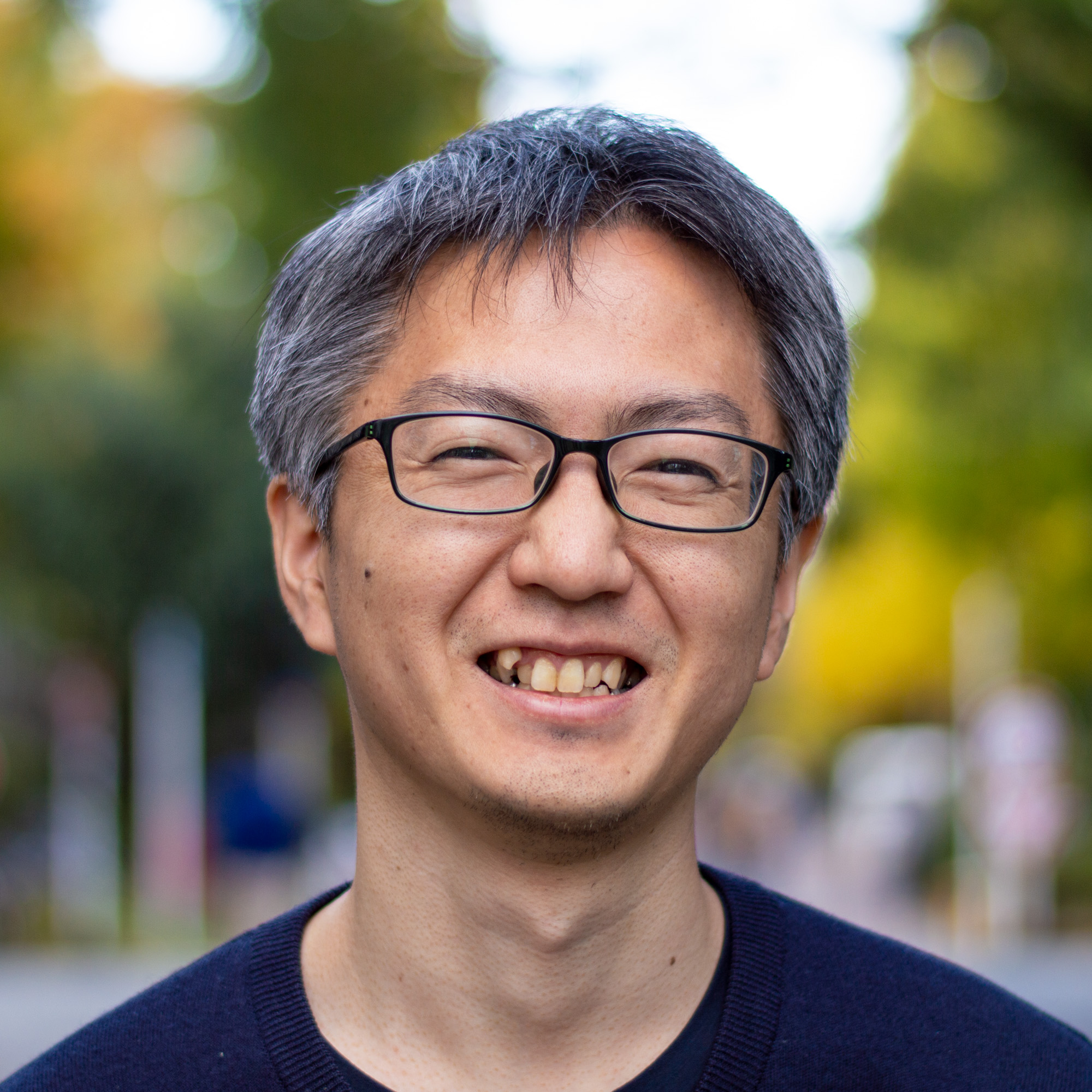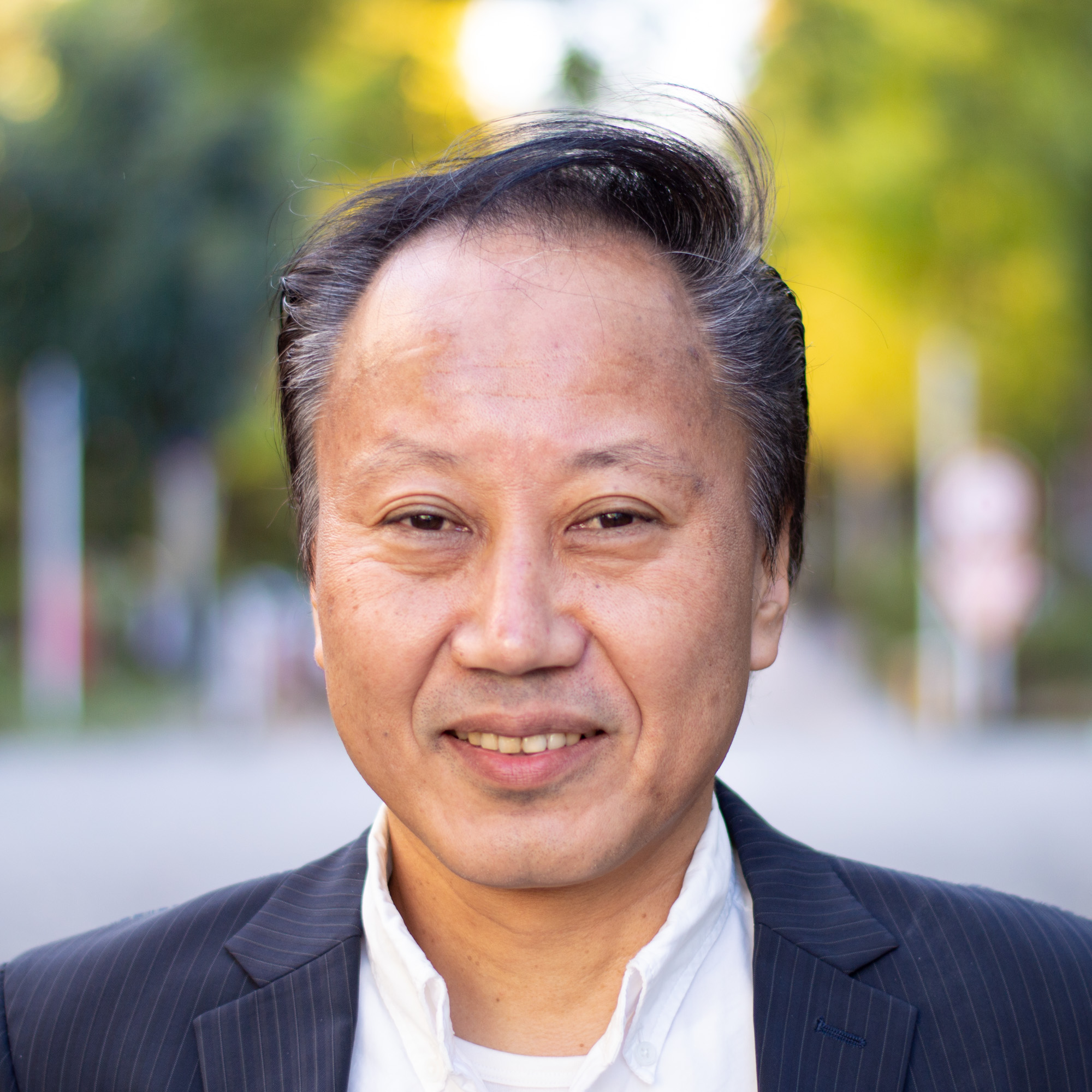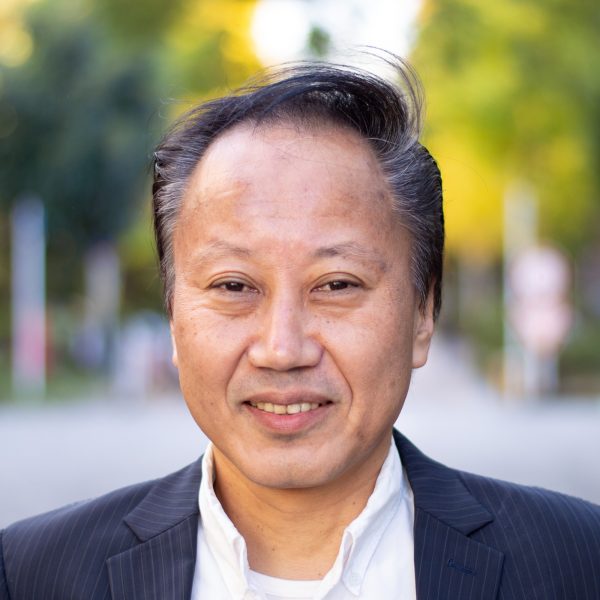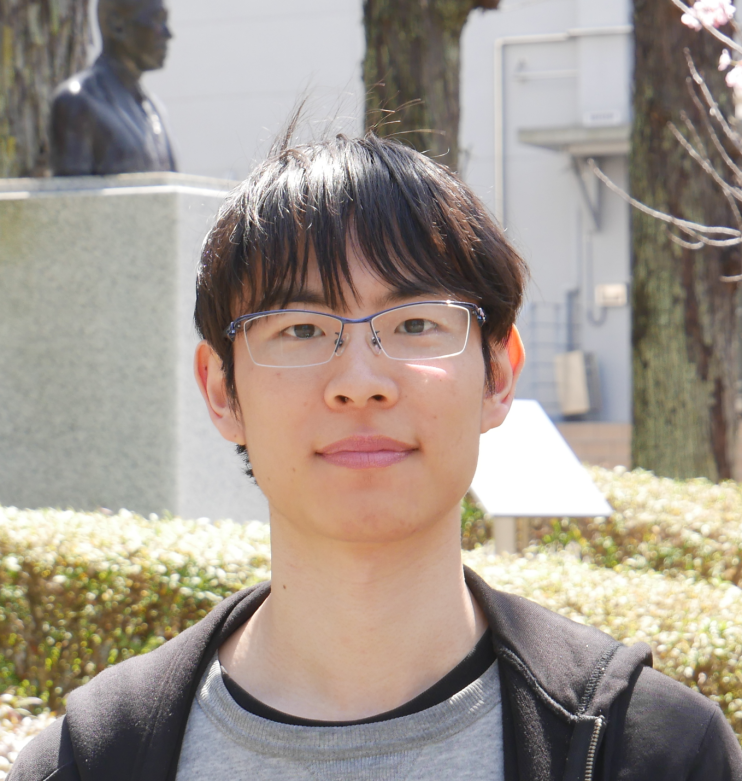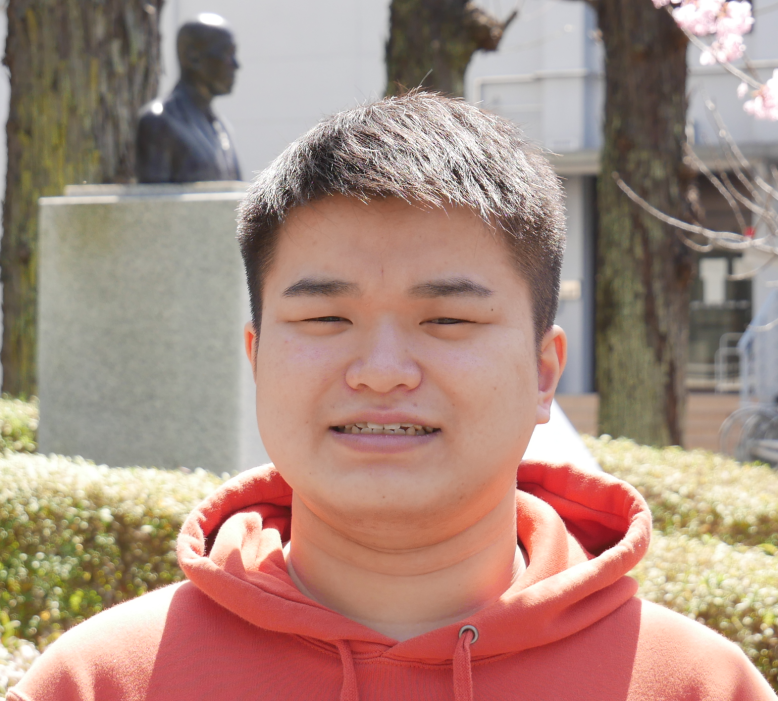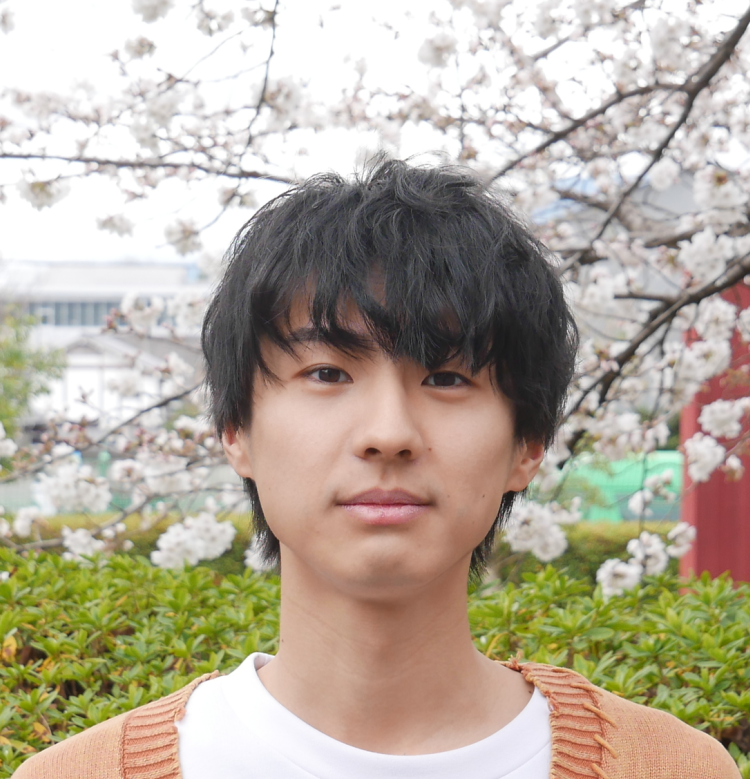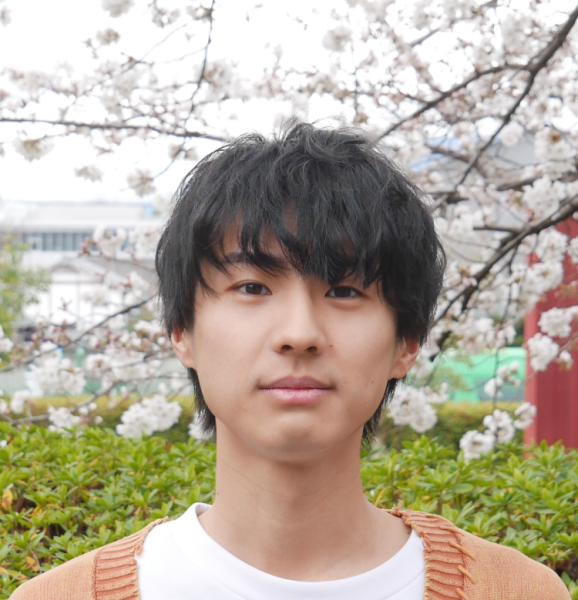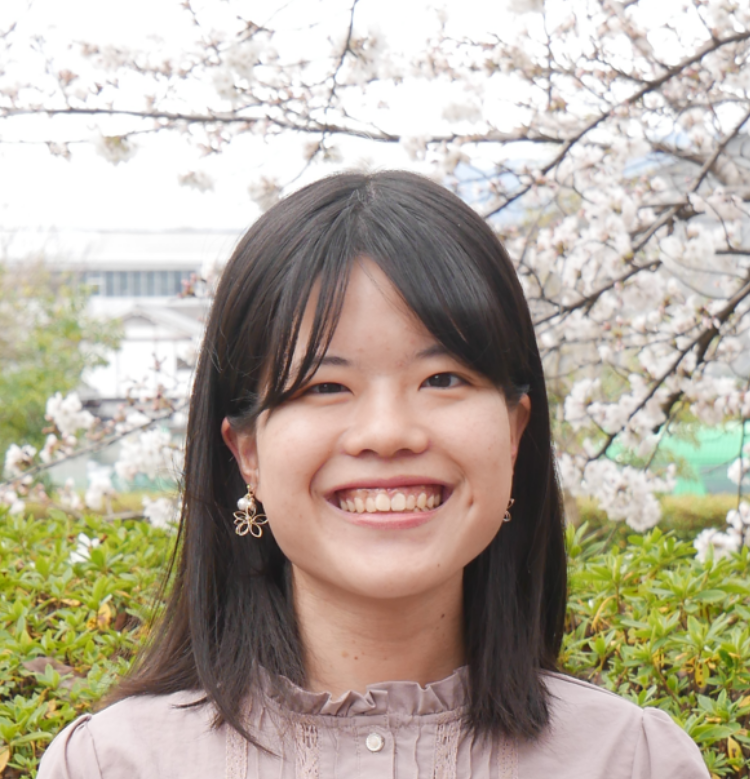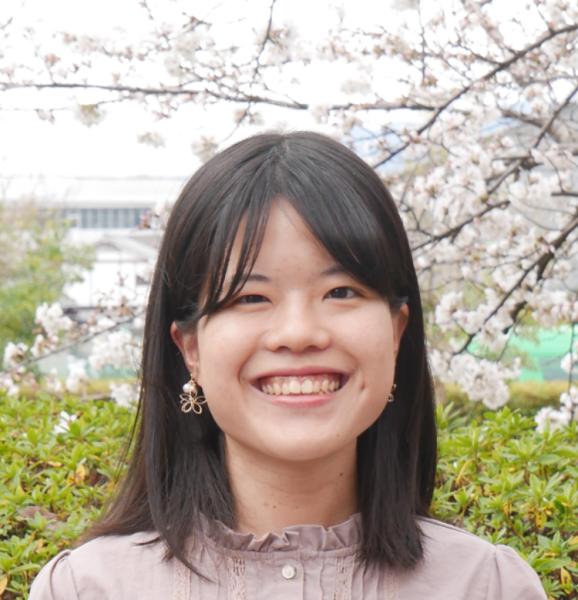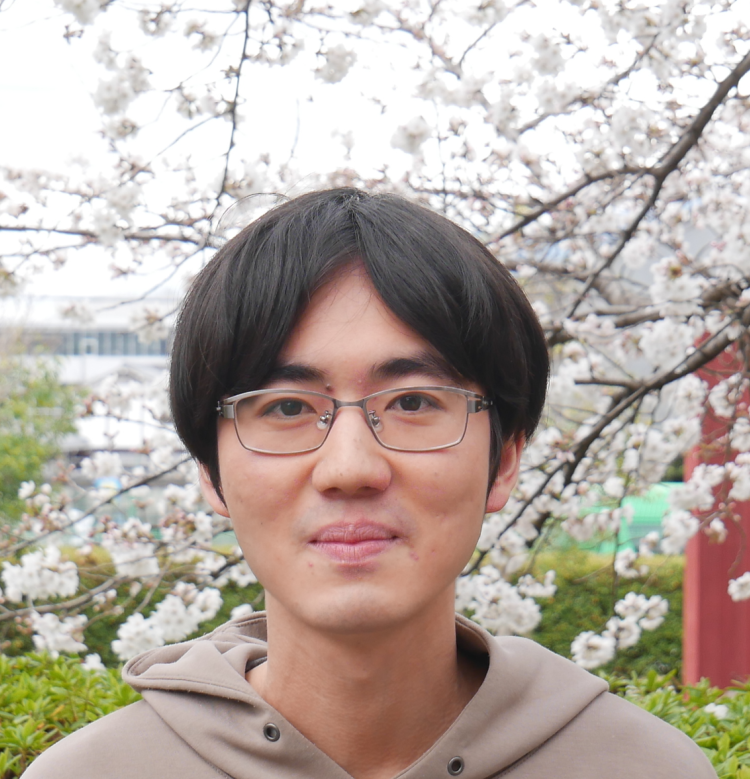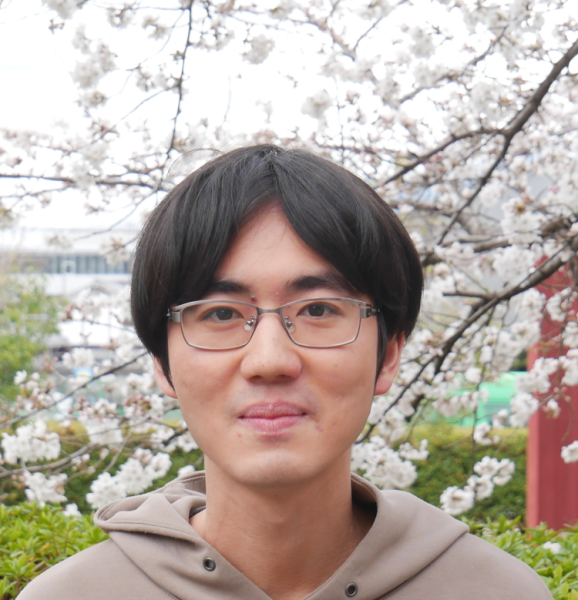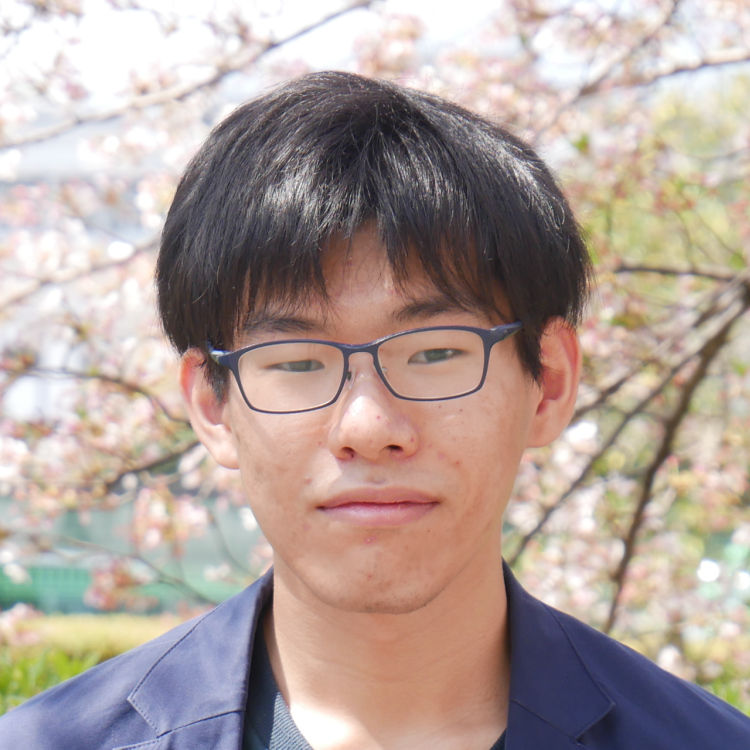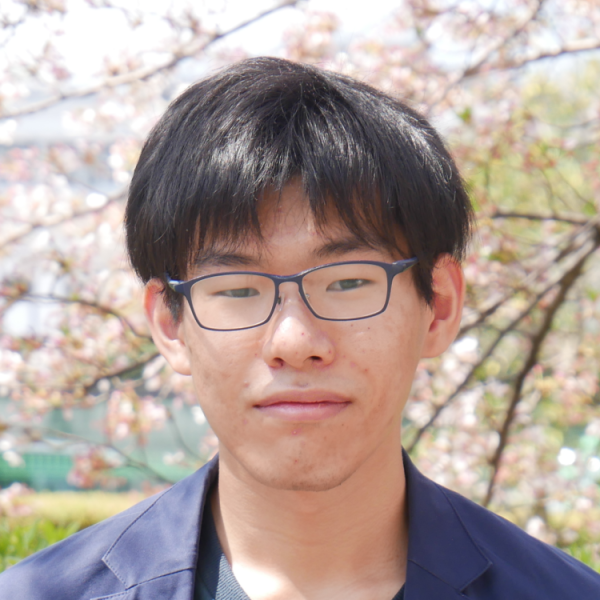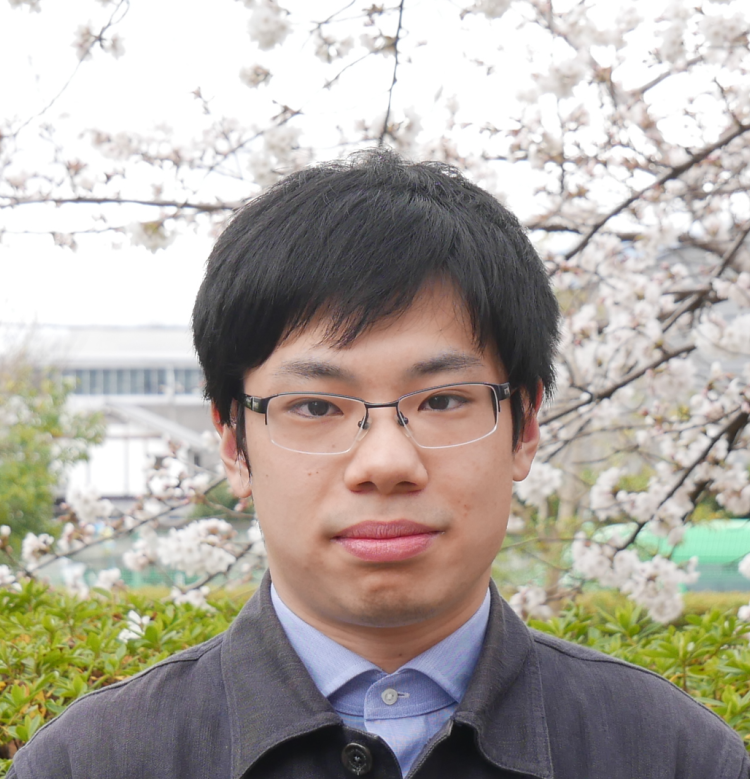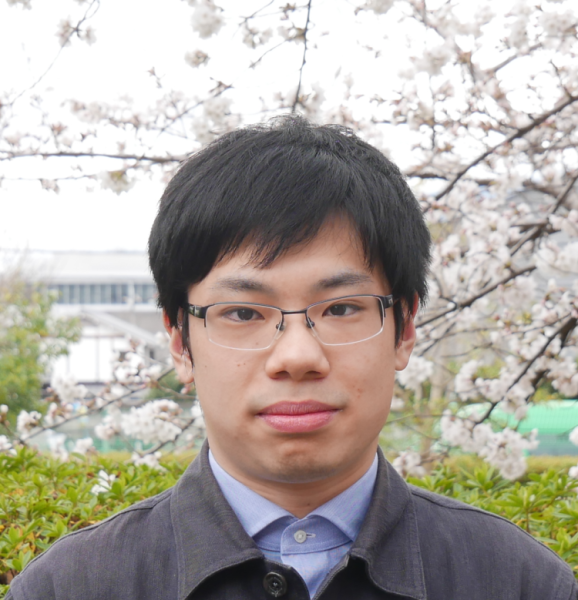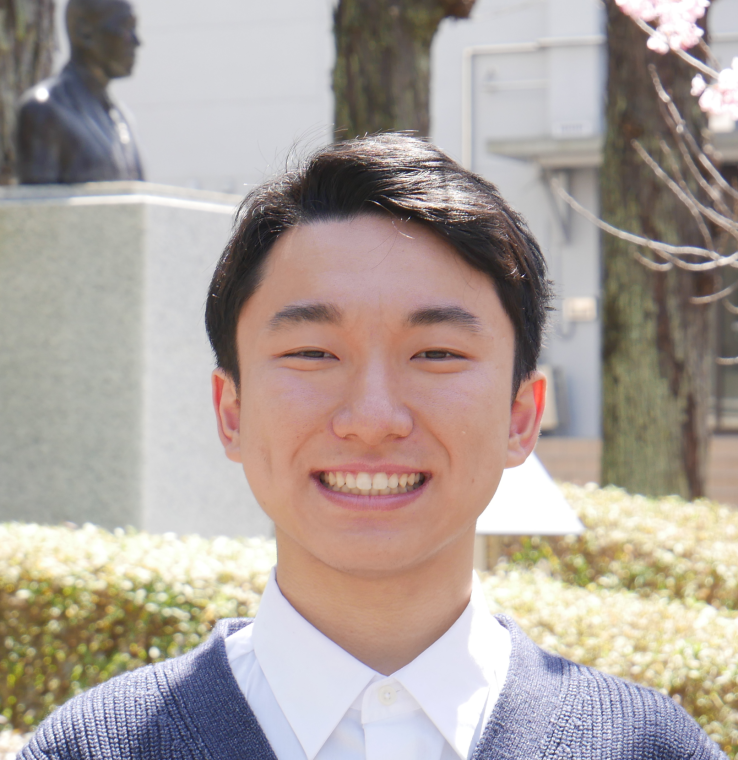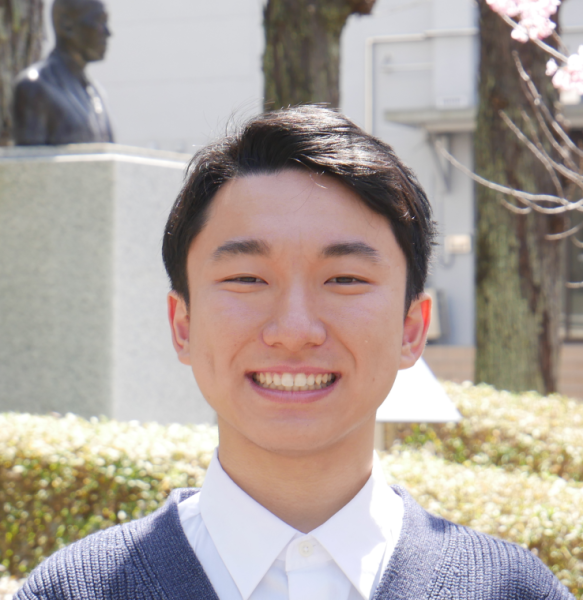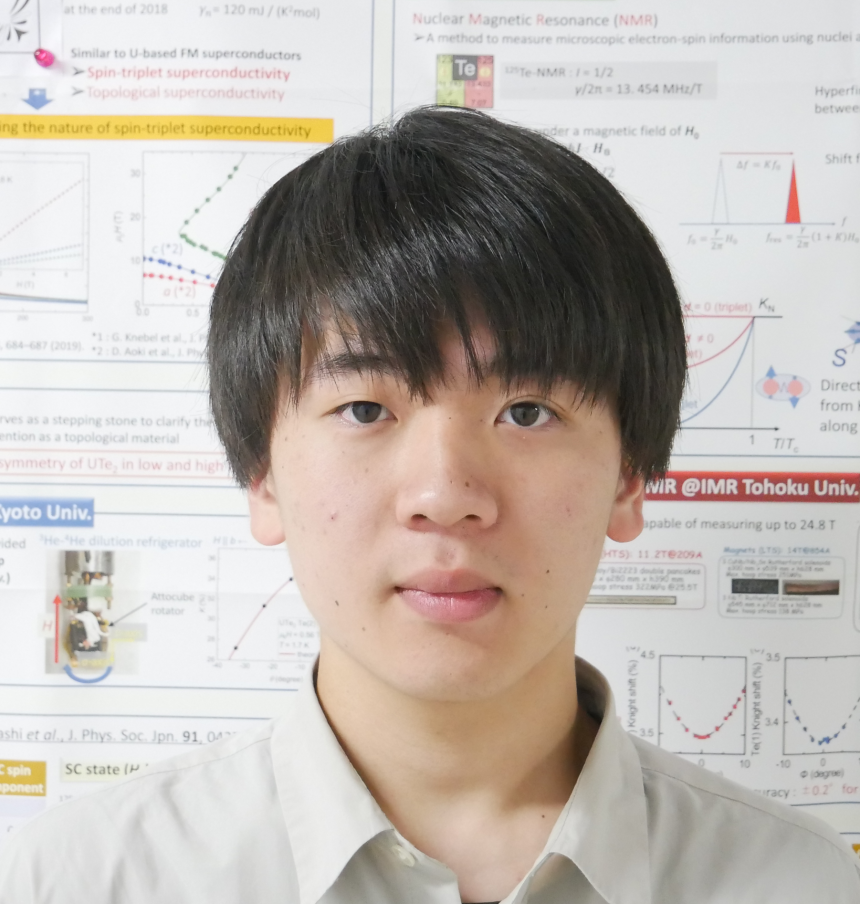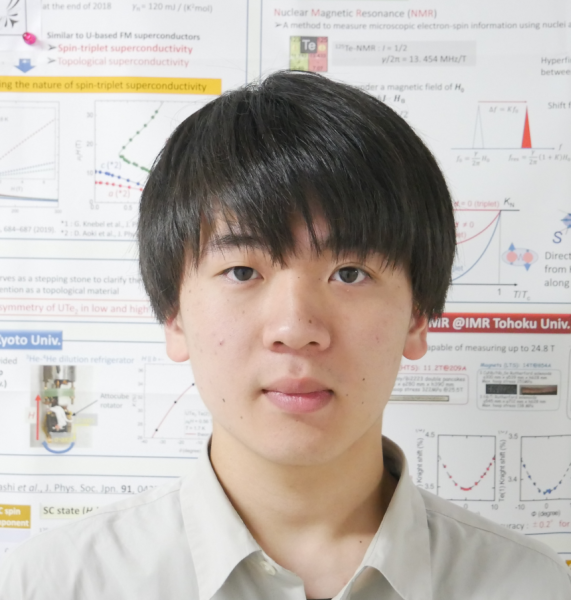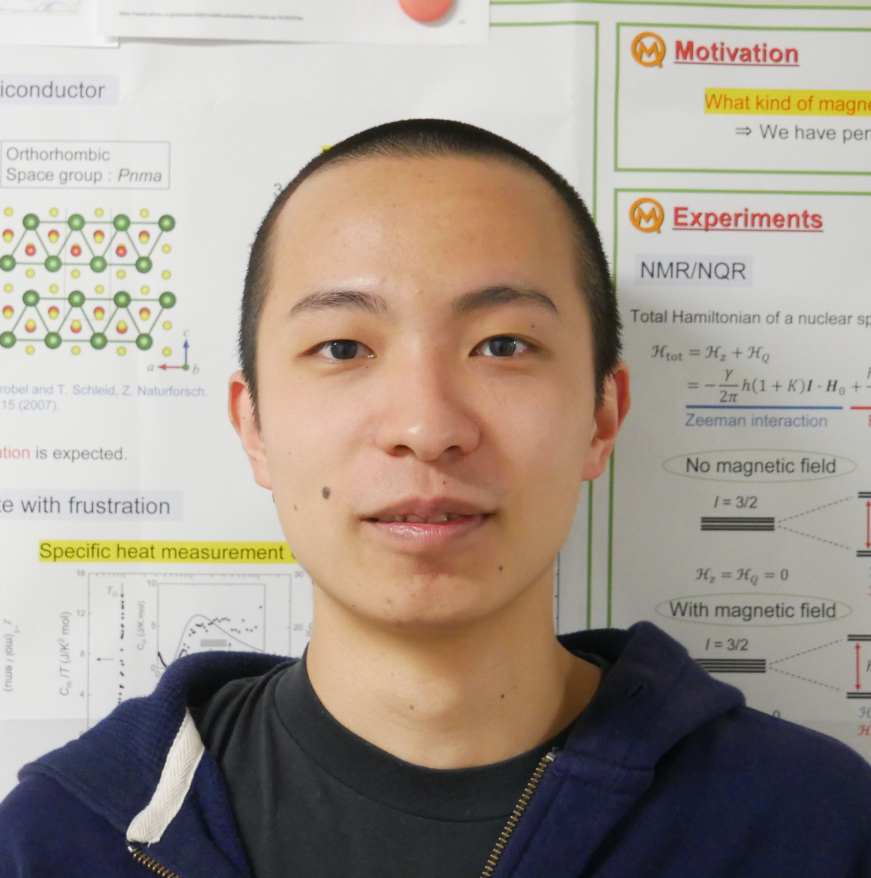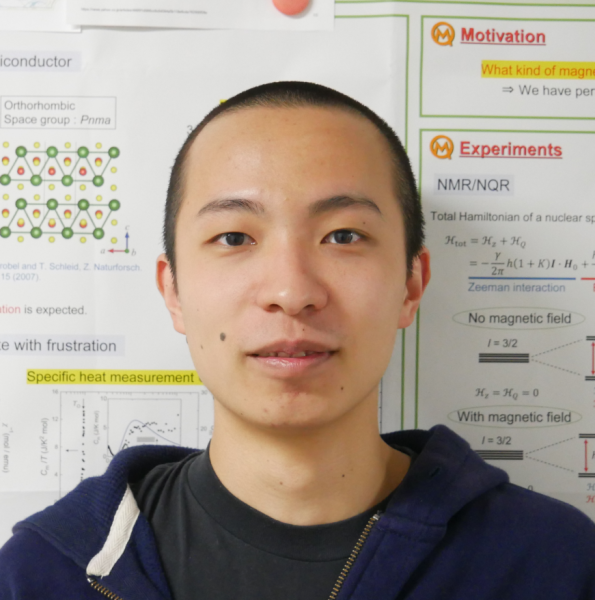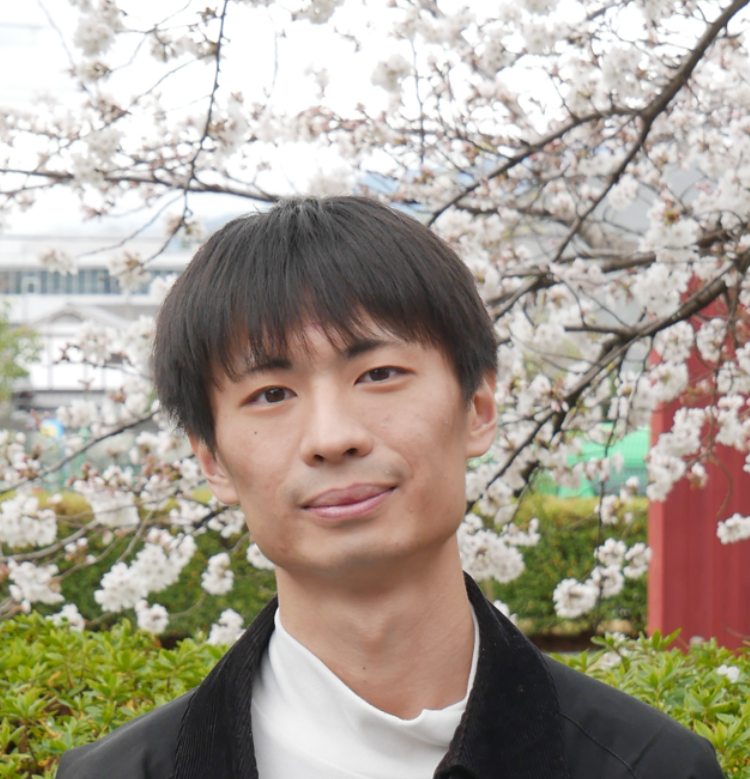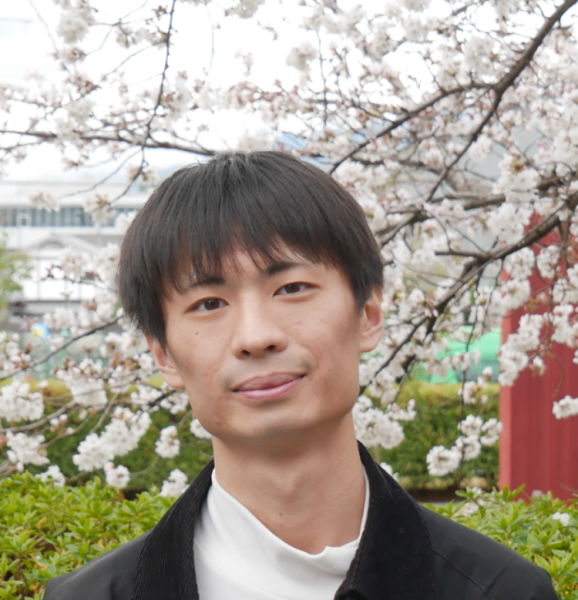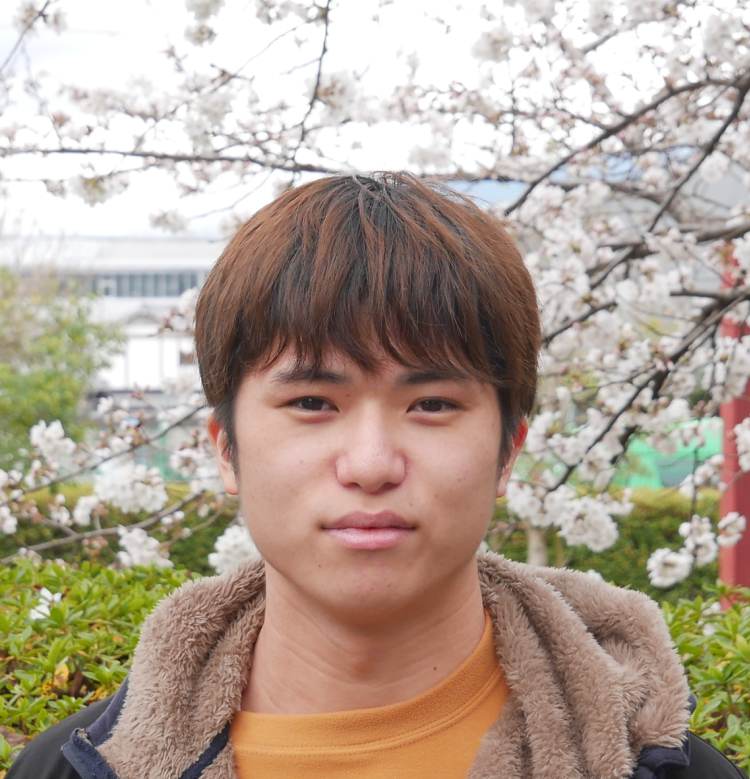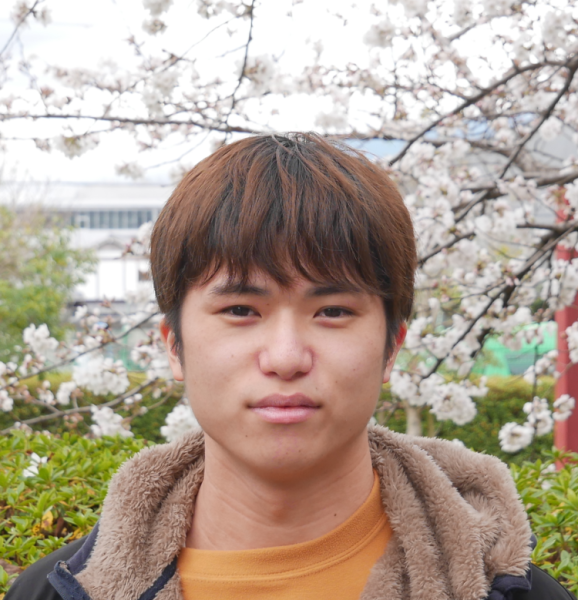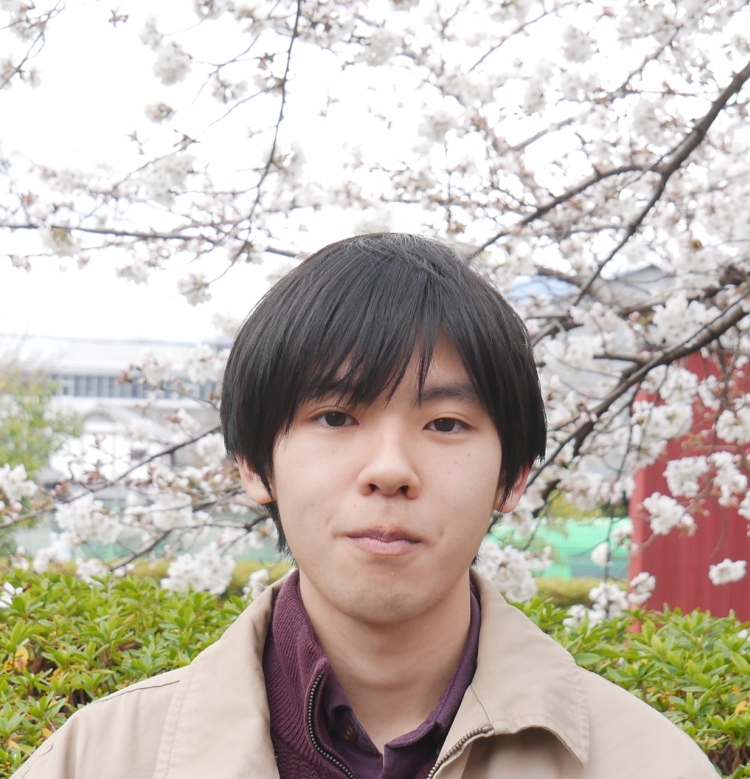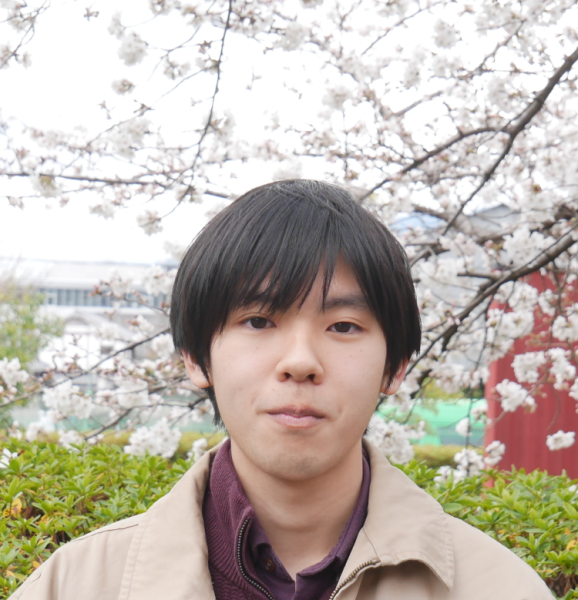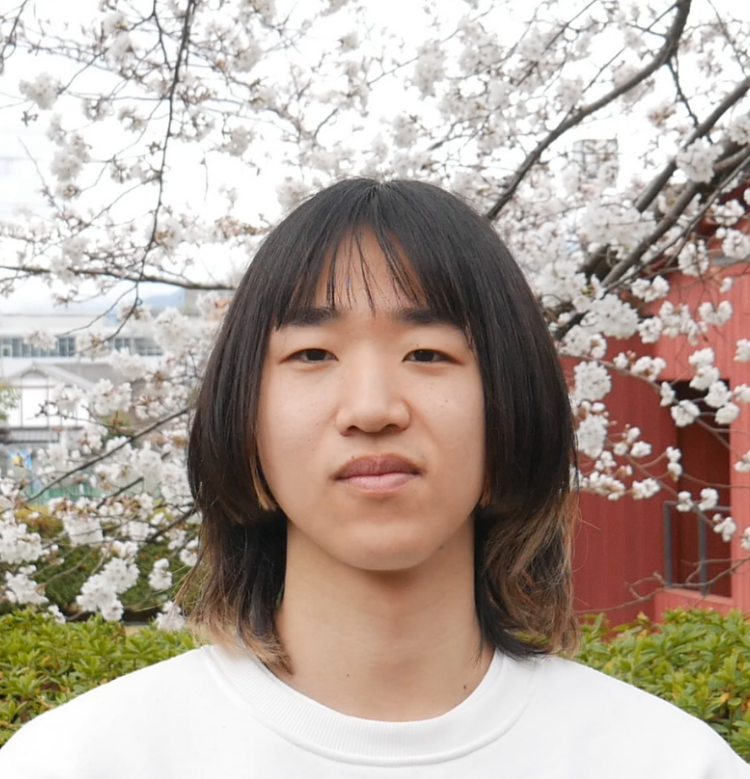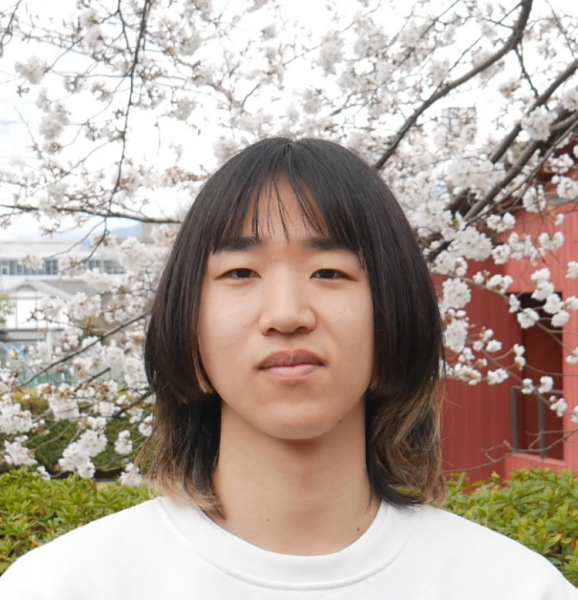スタッフ
博士後期課程
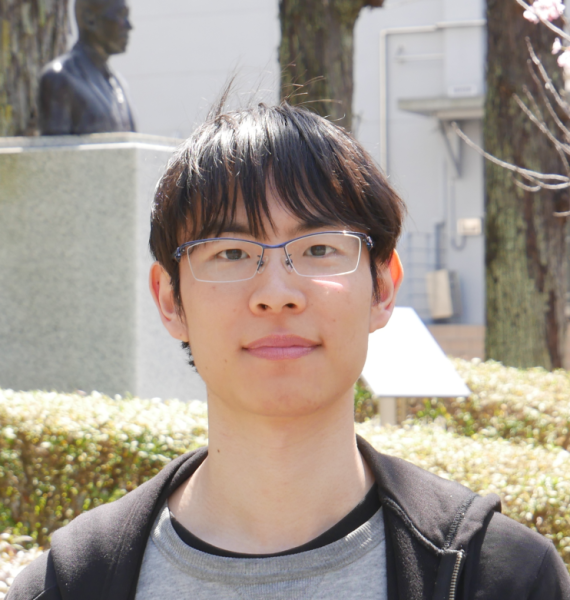
尾方 司貴
日本学術振興会特別研究員(DC2)
D3
134号室
3793
ogata.shiki.86c_at_st.kyoto-u.ac.jp
研究内容
局所的に空間反転対称性の破れた超伝導体における磁性と超伝導
研究で一番うれしかったことと一番つらかったこと
うれしかったこと:
自分の研究が起点になった研究が出たとき
辛かったこと:
数日かかる測定の途中でPCが再起動されたとき
[tplist author="1414"]
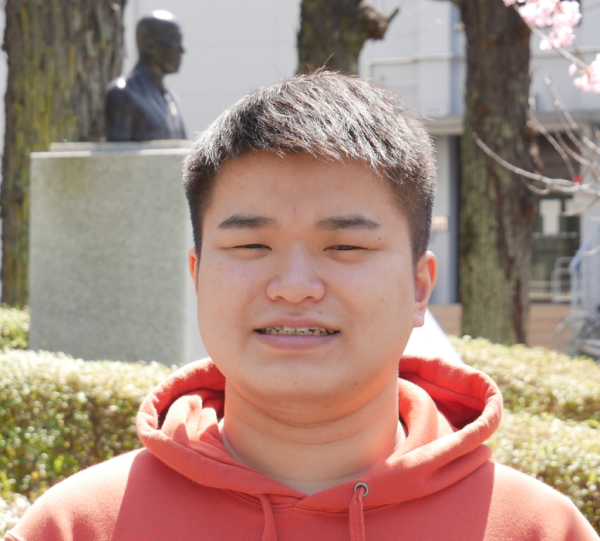
松村 拓輝
日本学術振興会特別研究員(DC2)
D2
139号室
3744
matsumura.hiroki.75r_at_st.kyoto-u.ac.jp
[tplist author="1462"]
修士課程
学部生
その他

固体 量子
バーチャル助教
Twitter
https://twitter.com/QM_phys_kyoto
YouTube
https://www.youtube.com/@kotairyoko

高橋 秀光
日本学術振興会特別研究員(PD)
学振PD
134号室
3793
takahashi.hidemitsu.23r_at_st.kyoto-u.ac.jp
個人のページ
研究内容
NMRによる超伝導体の研究
研究で一番うれしかったことと一番辛かったこと
嬉しかった事:信号が見えたとき
辛かった事:信号がいないとき
ひとこと
研究頑張ります。
[tplist author="888" exclude="521, 522"]

フェル美
ラボマスコット
139号室
出没場所 水槽
研究内容
研究で一番うれしかったことと一番辛かったこと
嬉しかった事:甲羅に水をかけてもらうこと
辛い事:皆に忘れられること
ひとこと
よろしくおねがいします。
元メンバー
当研究室の元スタッフや卒業生のリストです。アカデミック職でない場合、現職の情報は、掲載を許可して頂いた方のみ載せています。メールアドレスについては職種に関わらず掲載を許可して頂いた方のアドレスだけを載せています。
OB/OGの方へ: 異動されたりして情報の更新が必要な場合は北川までご一報ください。また、OB/OGのメーリングリストを作成しました。こちらでメールアドレスを把握していない方はまだ加入できていません。北川までご連絡いただければ、加入させていただきます。
| 最終在籍年 | 氏名 | 現職 | E-mailアドレス |
|---|---|---|---|
| 2022(教授) | 前野 悦輝 | 豊田理研 京大連携拠点 (TRiKUC) 連携拠点教授(豊田理研フェロー、京都大学名誉教授) | maeno.yoshiteru.b04_at_kyoto-u.jp |
| 2002(教授) | 石黒 武彦 | 京都大学 名誉教授 | t.ishig_at_rapid.ocn.ne.jp |
| 2023(准教授) | 米澤 進吾 | 京都大学 工学研究科電子工学専攻 教授 | yonezawa.shingo.3m_at_kyoto-u.ac.jp |
| 最終在籍年 | 氏名 | 現職 | E-mailアドレス |
|---|---|---|---|
| 2023 | 児玉 知子 | TRIKUC Web担当 | kodama.tomoko.2z_at_kyoto-u.ac.jp |
| 2022 | 岡崎 淳子 | 基礎物理学研究所 湯川記念室秘書室 事務補佐員 | |
| 2020 | 高宮 桂子 | ||
| 2015 | 伊藤 優子 | ||
| 2013 | 西村 ゆかり | ||
| 2011 | 蒲田 緩奈 | ||
| 2009 | 深原 優子 | ||
| 2009 | 塚本 玲奈 | ||
| 2008 | 村田 佳美 | ||
| 2005 | 小手川 (伊藤) 直子 | ||
| 2002 | 中島 司真子 |
| 最終在籍年 | 氏名 | 現職 | E-mailアドレス |
|---|---|---|---|
| 2006(客員教授) | Manfred SIGRIST | Professor, Institute for Theoretical Physics, ETH Zurich, Switzerland | |
| 2006(客員教授) | Andrew P. MACKENZIE | Professor, School of Physics & Astronomy, University of St. Andrews, UK | |
| 2006(客員助教授) | Glenn C. PAQUETTE | 京都大学 理学研究科 GCOE特定准教授 | |
| 2005(客員教授) | Douglas E. MACLAUGHLIN | University of California Riverside, USA | |
| 2005(客員助教授) | Antonio VECCHIONE | Consiglio Nazionale per le Ricerche, Istituto Nazionale per la Fisica della Materia, Italy | |
| 2004(客員助教授) | Oscar O. BERNAL | Program Director, Condensed Matter Physics, National Science Foundation, USA | Obernal_at_nsf.gov |
| 2004(客員助教授) | Santiago A. GRIGERA | University of St Andrews, UK | sag2_at_st-and.ac.uk |
| 2003(客員助教授) | Yatramohan JANA | Reader, Department of Physics, University of Kalyani, India | yatramohan_at_yahoo.com |
| 2001(客員教授) | Denis JEROME | Professor, Laboratoire de Physique des Solides, Universtite Paris Sud, France | |
| 2001(客員教授) | Andrei LEBED | Professor, Landau Institute, Russian Academy of Sciences, Russia | |
| 1999(客員教授) | Pierre MONCEAU | Professor, CNRS, Centre de Recherche sur les Tres Basses, France | |
| 1997(客員教授) | Rustem B. LYUBOVSKII | Professor, Institute of Chemical Physics, Russian Academy of Sciences, Russia | |
| 1996(客員教授) | Vladimir N. LAUKHIN | Professor, Institute of Solid State Physics, Russian Academy of Sciences, Russia |
| 最終在籍年 | 氏名 | 現職 | E-mailアドレス |
|---|---|---|---|
| 2023(PD) | Muhammad Waqee Ur Rehman QADRI | 講師, Government Post Graduate College, Pakistan | |
| 2022(PD) | Yajian HU | Hitachi High-Tech Corporation Engineer | |
| 2022(PD) | Giordano MATTONI | 京都大学高等研究院 特定助教 | mattoni_at_scphys.kyoto-u.ac.jp |
| 2022(PD) | Krishnan MAHALINGAM | 物材機構 ポスドク | |
| 2020(PD) | 池田 敦俊 | 京都大学 工学研究科電子工学専攻 助教 | ikeda.atsutoshi.3w_at_kyoto-u.ac.jp |
| 2020(特定助教) | 成田 秀樹 | 京都大学 化学研究所 小野研究室 特定助教 | narita.hideki.3x_at_kyoto-u.ac.jp |
| 2019(教務補佐員) | Ivan KOSTYLEV | 沖縄科学技術大学院大学 ポストドクター | |
| 2019(長期滞在院生) | Han-Shu XU | ||
| 2019(PD) | 谷口 貴紀 | takanori.taniguchi.d3_at_tohoku.ac.jp | |
| 2019(長期滞在院生) | Gwansuk OH | Postech, Korea | |
| 2019(PD) | Chanchal SOW | IIT Kanpur, India | |
| 2019(長期滞在院生) | Jinkwon KIM | Seoul National University, Korea | |
| 2019(長期滞在院生) | Marco Robert HOFFMANN | Phd Student, ETH Zurich, Switzerland | marco.hoffmann_at_mat.ethz.ch |
| 2018(長期滞在院生) | Igor MARKOVIC | School of Physics and Astronomy, Univesrity of St Andrews, The United Kingdom | |
| 2017(長期滞在院生) | Carla PALOMARES GARCIA | University of Cambridge, The United Kingdom | |
| 2017(長期滞在院生) | Han Gyeol LEE | Center for Correlated Electron Systems, Institute for Basic Science, Korea | |
| 2017(PD) | 山中 隆義 | 東北大学 金属材料研究所 附属強磁場超伝導材料研究センター 特任助教 | t-yamanaka_at_rs.tus.ac.jp |
| 2017(長期滞在院生) | Jan N. HAUSMANN | ||
| 2016(PD) | Muhammad Shahbaz ANWAR | University of Cambridge, The United Kingdom | |
| 2014(その他(学部生として研究参加)) | 田中 秀宣 | Senior Research Scientist, NTT Physics & Informatics (PHI) Laboratories, USA | |
| 2014(長期滞在院生) | Tim KNAEBLE | M1 student, TU Münich, Germany | tim.knaeble_at_mytum.de |
| 2014(長期滞在院生) | Kaveh LAHABI | PhD student, Leiden University, The Netherland | |
| 2013(長期滞在院生) | Kevin MORTIMER | M2 student, McMaster University, Canada | mortimkd_at_mcmaster.ca |
| 2012(長期滞在研究員) | Claude BERTHIER | Professor, Group leader, Solids NMR Group, CNRS Grenoble, France | |
| 2011(PD) | 中井 祐介 | 兵庫県立大学 物質理学研究科 准教授 | nakai_at_sci.u-hyogo.ac.jp |
| 2011(長期滞在院生) | Florian HUEBLER | The Karlsruhe Institute of Technology, Germany | |
| 2010(PD) | 井原 慶彦 | 北海道大学 理学研究院 物理学部門電子物性物理学分野 講師 | yihara_at_phys.sci.hokudai.ac.jp |
| 2010(PD) | Darren PEETS | Xide Fellow, Advanced Materials Laboratory, Fudan University, China | |
| 2010(PD) | Markus KRIENER | 理化学研究所 創発物性科学研究センター 強相関物質研究チーム 上級研究者 | markus.kriener_at_riken.jp |
| 2009(長期滞在院生) | Alex YING | The Pennsylvania State University | |
| 2009(長期滞在院生) | Paula GIRALDO | ||
| 2007(長期滞在院生) | Jake BOBOWSKI | University of British Columbia, Okanagan, Canada | Jake.Bobowski_at_ubc.ca |
| 2005(長期滞在院生) | Rosalba T. FITTIPALDI | Dipartimento di Fisica, Universita degli Studi di Salerno, Italy | |
| 2005(PD) | Robin S. PERRY | Royal Society Research fellow, Centre for Science at Extreme Conditions, School of Physics, The University of Edinburgh, UK | robin.perry_at_ed.ac.uk |
| 2005(長期滞在院生) | Nada JOO | ||
| 2004(PD) | 出口 和彦 | 名古屋大学 大学院理学研究科物理学教室 磁性物理学研究室(M研) 講師 | deguchi_at_nagoya-u.jp |
| 2003(長期滞在院生) | Joe HOOPER | ||
| 2003(PD) | 菊川 直樹 | 物質・材料研究機構 | |
| (PD) | Zhiqiang MAO | Associate Professor, Tulane University, USA | zmao_at_tulane.edu |
| 2003(PD) | 荒井 智史 | ||
| 2002(客員研究員) | Christos PANAGOPOULOS | Associate Professor, Department of Physics, University of Crete, Greece | |
| 2001(PD) | Alexey E. KOVALEV | University of Pennsylvania / Russian Academy of Sciences, USA / Russia | |
| 2001(PD) | Makariy A. TANATAR | Associate Scientist, Ames Lab, Iowa State University / Ukrainian Academy of Sciences, USA / Ukraine | |
| Andy TYLER | |||
| 1995(研究生) | 小川 雅史 | 京都府立南陽高等学校 | |
| 1995(PD) | Gennandiy Y. LOGVENOV | University of Augsburg / Russian Academy of Sciences, Germany / Russia | |
| 1994(PD) | Mark V. KARTSOVNIK | Bavarian Academy of Sciences and Humanities / Russian Academy of Sciences, Germany / Russia | |
| 1993(PD) | Yuri V. SUSHKO | University of Kentucky / Ukrainian Academy of Sciences, USA / Ukraine | |
| 1992(研究生) | 王 勇 |
| 最終在籍年 | 氏名 | 現職 | E-mailアドレス |
|---|---|---|---|
| 2025 | 堀 文哉 | 東北大学 巨視的量子物性研究室 助教 | |
| 2023 | 金城 克樹 | 東北大学 多元物質科学研究所 助教 | katsuki.kinjo.c6_at_tohoku.ac.jp |
| 2021 | 仲嶺 元輝 | ||
| 2020 | 池田 敦俊 | 京都大学 工学研究科電子工学専攻 助教 | ikeda.atsutoshi.3w_at_kyoto-u.ac.jp |
| 2019 | Ivan KOSTYLEV | 沖縄科学技術大学院大学 ポストドクター | |
| 2019 | 安井 勇気 | 東京大学 新領域創成科学研究科 杉本研究室 助教 | |
| 2019 | 真砂 全宏 | 島根大学 総合理工学部 物理・マテリアル工学科 助教 | manago_at_riko.shimane-u.ac.jp |
| 2018 | Mohamed OUDAH | ブリティッシュコロンビア大学 ポストドクトラルフェロー | mohamed.oudah_at_ubc.ca |
| 2018 | 施 安路 | CIC Japan Innovation Services合同会社 プロジェクトアソシエイト/イノベーションコンサルタント | anlu.shi_at_cic.com |
| 2016 | 山中 隆義 | t-yamanaka_at_rs.tus.ac.jp | |
| 2016 | Marco-Polo JIMENEZ-SEGURA | Associate Professor C, Faculty of Chemistry, National Autonomous University of Mexico, Mexico | mpolo_at_unam.mx |
| 2015 | 軽部 皓介 | 国立研究開発法人 理化学研究所 創発物性科学研究センター 創発機能磁性材料研究ユニット ユニットリーダー | |
| 2014 | 家 哲也 | 株式会社構造計画研究所 通信システム部 エンジニアリングコンサルタント | tetsuya-iye_at_kke.co.jp |
| 2014 | 谷口 晴香 | 名古屋大学 工学研究科 応用物理学専攻 柏谷研究室 講師 | taniguchi.haruka.a5_at_f.mail.nagoya-u.ac.jp |
| 2013 | 江口 学 | ||
| 2013 | 北川 俊作 | 京都大学 理学研究科 固体量子物性研究室 准教授 | kitagawa.shunsaku.8u_at_kyoto-u.ac.jp |
| 2012 | 中村 壮智 | 福岡工業大学 工学研究科 電子情報工学専攻 准教授 | |
| 2010 | 橘高 俊一郎 | 東京大学 大学院総合文化研究科 准教授 | kittaka_at_g.ecc.u-tokyo.ac.jp |
| 2010 | 高津 浩 | 京都大学 大学院工学研究科 物質エネルギー化学専攻 陰山研究室 准教授 | takatsu_at_scl.kyoto-u.ac.jp |
| 2009 | 中井 祐介 | 兵庫県立大学 物質理学研究科 准教授 | nakai_at_sci.u-hyogo.ac.jp |
| 2009 | 南部 雄亮 | 東北大学 理学研究科 物理学専攻 准教授 | |
| 2008 | 井原 慶彦 | 北海道大学 理学研究院 物理学部門電子物性物理学分野 講師 | yihara_at_phys.sci.hokudai.ac.jp |
| 2008 | 米澤 進吾 | 京都大学 工学研究科電子工学専攻 教授 | yonezawa.shingo.3m_at_kyoto-u.ac.jp |
| 2007 | 北川 健太郎 | 東京大学 物性研 准教授 | kitag_at_issp.u-tokyo.ac.jp |
| 2007 | 村川 寛 | 大阪大学 理学研究科 物理学専攻 助教 | murakawa_at_phys.sci.osaka-u.ac.jp |
| 2007 | 町田 洋 | 学習院大学 理学部物理学科 教授 | yo.machida_at_gakushuin.ac.jp |
| 2006 | 東中 隆二 | 首都大学東京 大学院理工学研究科 物理学専攻 電子物性研究室 助教 | higashinaka_at_phys.se.tmu.ac.jp |
| 2004 | 出口 和彦 | 名古屋大学 大学院理学研究科物理学教室 磁性物理学研究室(M研) 講師 | deguchi_at_nagoya-u.jp |
| 2003 | 深澤 英人 | 千葉大学 大学院理学研究院 准教授 | hideto_at_chiba-u.jp |
| 2002 | 下城 義朗 | ||
| 2001 | 中辻 知 | 東京大学 物性研究所 新物質科学研究部門 教授 | satoru_at_issp.u-tokyo.ac.jp |
| 2001 | 中払 周 | 物質・材料研究機構 MANA-ナノシステム分野 パイ電子エレクトロニクスユニット MANA研究者 | |
| 2001 | 南方 雅成 | ||
| 2000 | 大道 英二 | 神戸大学 大学院理学研究科 准教授 | ohmichi_at_harbor.kobe-u.ac.jp |
| 2000 | 西崎 修司 | 京都大学 工学研究科付属桂インテックセンター 技術職員 | nishizaki.shuji.6u_at_kyoto-u.ac.jp |
| 1999 | 増井 孝彦 | 近畿大学 大学院総合理工学研究科 理学専攻 物理学分野 准教授 | |
| 1998 | 羽田 英樹 | 三菱電機株式会社 弁理士 | |
| 1998(広島大学) | 池田 伸一 | 国立研究開発法人産業技術総合研究所 インダストリアルCPS研究センター ミニマル試作研究チーム チーム長 | ikeda-shin_at_aist.go.jp |
| 1997 | Taliq H. GILANI | ||
| 1996 | 小笠原 一禎 | 関西学院大学 理工学部 化学科 教授 | |
| 1994 | 金子 浩 | 金沢大学 大学院自然科学研究科 数物科学専攻 超低温研究室 助教 | |
| 1993 | 伊東 裕 | 名古屋大学 大学院工学研究科 マテリアル理工学専攻 応用物理学分野 量子物理工学講座量子物性工学研究グループ (黒田研) 准教授 | ito_at_nuap.nagoya-u.ac.jp |
博士課程に進学された方は「元博士課程学生」の欄に記載しています。
| 最終在籍年 | 氏名 | 現職 | E-mailアドレス |
|---|---|---|---|
| 2025 | 井原 大志 | 三菱電機株式会社 技術系総合職 | |
| 2025 | 柴田 真咲 | 株式会社JERA | |
| 2025 | 高橋 侑希 | ||
| 2025 | 泉岡 翔太 | 経営コンサルタント | |
| 2024 | 富川 幹也 | 特許庁 特許審査官 | tomikawa-mikiya_at_jpo.go.jp |
| 2023 | 山根 聡一郎 | 京都大学 工学研究科電子工学専攻 博士後期課程 | yamane.soichiro.73f_at_st.kyoto-u.ac.jp |
| 2023 | 福島 和実 | 会社員 IT系 | |
| 2023 | 藤林 裕己 | 株式会社日立製作所 グローバル知的財産統括本部 | fujibayashi.hiroki.w49_at_kyoto-u.jp |
| 2023 | 松原 匠矢 | ||
| 2023 | 木村 直博 | 三菱電機株式会社 技術系総合職 | |
| 2022 | 荒木 遼 | 古河電気工業株式会社 研究開発本部 | araki.ryo.z52_at_kyoto-u.jp |
| 2022 | 小畑 慶人 | 三菱電機株式会社 先端技術総合研究所 研究開発職 | |
| 2022 | 木下 雄大 | ||
| 2021 | 木舩 茉悠 | ||
| 2021 | 谷口 諒 | ||
| 2021 | 川口 真世 | ||
| 2021 | 松﨑 聡 | ||
| 2020 | 奥野 友則 | ||
| 2020 | 鯉渕 駿 | JFEスチール(株) 技術系総合職 | |
| 2020 | 三好 拓人 | 株式会社日立製作所 研究開発 | |
| 2019 | 沼崎 凌 | ||
| 2019 | 諏訪 春輝 | サンディスク株式会社 | |
| 2018 | 河村 健志 | 富士通株式会社 | |
| 2018 | 國枝 正直 | ||
| 2018 | 米川 和志 | 株式会社岩波書店 | |
| 2018 | 龍見 勇輝 | Massachusetts Institute of Technology, USA | |
| 2017 | 高木 亮一 | 株式会社レゾナック 開発職 | |
| 2017 | 田尻 兼悟 | NTT研究所 | |
| 2017 | 樋口 匠 | 横河電機株式会社 IAシステム&サービス事業本部システム開発センター | |
| 2016 | 杉本 雄亮 | ||
| 2016 | 西宮 大輔 | ||
| 2015 | 杉本 大輔 | ウエスタンデジタル合同会社 | |
| 2015 | 柴田 大輔 | 京都大学 大学院人間・環境学研究科 相関環境学専攻 博士課程 | shibata.daisuke.72w_at_st.kyoto-u.ac.jp |
| 2015 | 新井 健司 | ||
| 2014 | 川島 裕貴 | ||
| 2014 | 中村 有志 | キヤノン株式会社 | |
| 2013 | 梶川 知宏 | 横河電機株式会社 | |
| 2013 | 山岡 義史 | 株式会社エクサウィザーズ AIプラットフォーム事業部 | |
| 2012 | 鷲見 拓哉 | Akamai Technologies G. K. APJ Security Services Division | |
| 2012 | 石川 諒 | パナソニック株式会社 マニュファクチュアリングソリューションズ社 パナソニック溶接システム株式会社 技術グループ 熱源開発チーム | |
| 2011 | 山岸 達哉 | 株式会社村田製作所 品質保証グループ故障解析センタ故障物理解析課 | |
| 2010 | 中川 竜司 | 株式会社日立製作所 エネルギー・環境システム研究所 | |
| 2009 | 大田 哲也 | キヤノン株式会社 映像事務機事業本部 映像事務機商品開発センター | |
| 2009 | 菅原 仁 | ルネサスエレクトロニクス株式会社 IoTインフラ事業本部 共通EDA技術開発統括部 | |
| 2009 | 田中 壮太郎 | シャープ(株) 研究開発本部 先端技術研究所 先端技術開発室(解析) 主事 | Tanaka.sohtaroh_at_sharp.co.jp |
| 2008 | 久我 健太郎 | 豊田工業大学 エネルギー材料研究室 | kuga_at_mag.ahmf.sci.osaka-u.ac.jp |
| 2008 | 青野 有造 | ||
| 2008 | 草場 壽一 | ||
| 2007 | 小沼 圭介 | ||
| 2007 | 竹谷 英朗 | 旭化成エレクトロニクス(株) | |
| 2006 | 馬地 佑記 | 京セラ | |
| 2006 | 殿村 宏史 | ||
| 2006 | 房登 真司 | ||
| 2005 | 齋藤 将史 | 京セラドキュメントソリューションズ | |
| 2005 | 滝沢 恵一 | ||
| 2005 | Matthew S. FAGAN | ||
| 2004 | 坂井 修 | 日本オーチスエレベーター(株) | |
| 2003 | 山田 真弘 | ||
| 2003 | 吉岡 正樹 | ||
| 2002 | 鈴木 誠 | 株式会社日立ハイテクノロジーズ 電子デバイスシステム事業統括本部 | makoto.suzuki.yj_at_hitachi-hightech.com |
| 2002 | 柳島 大輝 | ローム株式会社 | |
| 2002 | 和田 将彦 | ||
| 2001 | 神谷 聡 | ||
| 2001 | 菅原 賢悟 | 近畿大学 理工学部 電気電子通信工学科 准教授 | ksugahar_at_kindai.ac.jp |
| 2001 | 永井 修一 | ||
| 2000 | 秋間 崇 | 公立中学校 教諭 | |
| 2000 | 川崎 隆史 | ||
| 2000 | 長谷川 了示 | ||
| 1999 | 安藤 貴史 | ||
| 1998 | 木下 平 | 日本アルカテル・ルーセント株式会社 シニアマネージャー | |
| 1998 | 森 康充 | ||
| 1997 | 中田 隆之 | 日本アイ・ビー・エム株式会社 | |
| 1997 | 谷井 (石島) 由美子 | ||
| 1996 | 山内 康寛 | ||
| 1995 | 松浦 誠司 | ||
| 1995 | 松崎 秀昭 | ||
| 1994 | 伊高 健治 | 弘前大学 地域戦略研究所 新エネルギー研究部門 教授 | itaka_at_hirosaki-u.ac.jp |
| 1993 | 竹内 繁樹 | 京都大学 大学院工学研究科電子工学専攻 教授 | |
| 1992 | 北林 博人 | 日本電信電話株式会社 環境エネルギー研究所 主幹研究員 | |
| 1992 | 佐藤 健史 | ||
| 1992 | 山下 元治 |
修士課程まで進学された方は「元修士課程学生」に、博士課程に進学された方は「元博士課程学生」の欄にそれぞれ記載しています。
| 最終在籍年 | 氏名 | 現職 | E-mailアドレス |
|---|---|---|---|
| 2025 | 濱田 駿之介 | ||
| 2024 | 中西 宏介 | 京都大学 量子凝縮物性研究室 修士課程 | |
| 2024 | 酒井 葵生 | 京都大学 量子凝縮物性研究室 修士課程 | |
| 2023 | 能登 滉太 | 京都大学 基礎物理学研究所 修士課程 | |
| 2023 | 矢野 翔太 | 東京大学 数理 修士課程 | root1456849_at_gmail.com |
| 2022 | 松宮 香子 | ||
| 2021 | 清末 俊紀 | 京都大学 理学研究科 量子凝縮物性研究室 修士課程 | |
| 2021 | 小林 琢実 | 京都大学 理学研究科 低温物理学研究室 修士課程 | |
| 2020 | 矢田 歌菜絵 | ||
| 2018 | 高須賀 幸恵 | ||
| 2018 | 寺尾 奈浦 | ||
| 2017 | 宍倉 愛 | 京都大学 理学研究科 地球惑星科学専攻 地質学鉱物学分野 地球テクトニクス講座 | shishikura_at_kueps.kyoto-u.ac.jp |
| 2016 | 浦井 智崇 | 京都大学 理学研究科物理学第一教室 ソフトマター物理 | torarino.totoro_at_gmail.com |
| 2016 | 岡本 賢志郎 | 大阪大学 大学院基礎工学研究科 鈴木義茂研究室 博士前期課程 | tiisakuhabatakou090_at_gmail.com |
| 2016 | 中田 勝 | 富士通株式会社 富士通研究所 量子研究所 研究員 | |
| 2015 | 成塚 政裕 | ||
| 2014 | 花岡 洋祐 | 京都大学 大学院理学研究科物理学第一分野 ナノ量子物性研究室 | hanasan8748471_at_yahoo.co.jp |
| 2013 | 竹中 耕平 | ||
| 2012 | 下田 愛子 | ||
| 2012 | 立石 圭児 | ||
| 2012 | 宮崎 慈生 | ||
| 2011 | 中村 昌幸 | 京都大学 大学院理学研究科物理学第一分野 ナノ量子物性研究室 | nakamura03_at_scphys.kyoto-u.ac.jp |
| 2011 | 前川 紘紀 | 大阪府立高津高校 教諭(理科) | |
| 2010 | 石川 洵 | 東京大学 物性研究所 中辻研究室 | jun_at_issp.u-tokyo.ac.jp |
| 2010 | 松坂 純輝 | ||
| 2009 | 池田 達哉 | ||
| 2008 | 山本 慧 | ||
| 2008 | 岡本 純一 | ||
| 2007 | 島居 宣博 | ||
| 2007 | 林 優二郎 | ||
| 2007 | 矢野 史朗 | ||
| 2006 | 小野寺 真吾 | ||
| 2006 | 中村 秀司 | ||
| 2006 | 村主 崇行 | ||
| 2005 | 大西 高史 | 株式会社NTTデータ | |
| 2005 | 加納 聖士 | ||
| 2005 | 久田 旭彦 | 徳島大学 大学院ソシオ・アーツ・アンド・サイエンス研究部 基礎科学研究部門 助教 | |
| 2005 | 平野 大輔 | ||
| 2004 | 鎌田 宗康 | ||
| 2004 | 山下 真 | ||
| 2004 | 弓削 達郎 | 静岡大学 理学部 助教 | |
| 2003 | 佐藤 功 | ||
| 2003 | 佐藤 剛 | ||
| 2003 | 森本 隆之 | ||
| 2002 | 大屋 雄 | ||
| 2002 | Tran T. TRUNG | ||
| 2002 | 矢野 賢太郎 | ||
| 2001 | 採田 祥治 | ||
| 2001 | 辻 幸秀 | ||
| 2000 | 久保 拓右 | ||
| 2000 | 西守 有人 | プライムワークス国際特許事務所 | |
| 1999 | 上藤 哲嗣 | ||
| 1999 | 岩本 孝昌 | ||
| 1999 | 大澤 直樹 | ||
| 1998 | 安立 裕人 | 岡山大学 異分野基礎科学研究所 准教授 | |
| 1998 | 仁張 茂樹 | ||
| 1998 | 野村 拓司 | 国立研究開発法人量子科学技術研究開発機構 量子ビーム科学研究部門 放射光科学研究センター | |
| 1997 | 石原 博史 | ||
| 1997 | 金 海永 | ||
| 1997 | 武田 輝久 | ||
| 1995 | 藤井 裕 | 福井大学 遠赤外領域開発研究センター 准教授 | fujii_at_apphy.u-fukui.ac.jp |
| 1994 | 塚田 浩 | ||
| 1992 | 狐崎 創 | 奈良女子大学 大学院人間文化研究科 複合現象科学専攻 助教 | kitsune_at_ki-rin.phys.nara-wu.ac.jp |
| 1992 | 渡邉 真史 | ||
| 1991 | 紺谷 浩 | 名古屋大学 理学研究科 物理学専攻 物性理論研究室(S研) 教授 | kon_at_slab.phys.nagoya-u.ac.jp |
| 1991 | 濱中 博士 |
![]()
